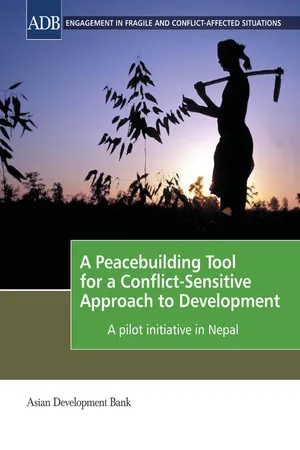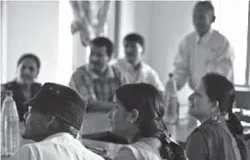![]()
Chapter 1: Introduction
Various international efforts are being made to improve aid effectiveness in countries facing fragility or countries in transitioning status. The OECD has issued a set of guidelines for improving engagement in FCASs by the international community. Formally referred to as the Principles for Good International Engagement in Fragile States and Situations, these guidelines are often called by their shorter name, the “Fragile States Principles.”1 All signatories to the Paris Declaration on Aid Effectiveness agreed to develop a genuine partnership with developing countries that embodies the fundamental principles of ownership, alignment, harmonization, results, and mutual accountability as means of achieving concrete results.2 Further, the Accra Agenda for Action identifies three major challenges to accelerating progress in aid effectiveness: country ownership, building more effective and inclusive partnerships, and achieving development results and openly accounting for them.3
Sensitivity to conflict entails various efforts, methods, and tools for working in conflict-prone or conflict-affected areas. A conflict-sensitive approach is expected to reduce the risks of development aid unintentionally contributing to escalation of violent conflict, as well as to directly contribute to peacebuilding.
OECD defines a fragile state as a state with a weak capacity to carry out the basic state functions of governing a population and its territory, and lacks the ability or political will to develop mutually constructive and reinforcing relations with society (footnote 1). Another view is that fragile states are states that are failing, or are at risk of failing with respect to authority, provision of basic services, or legitimacy. Service lapses may occur due to lack of capacity for, or lack of commitment to service delivery.4 Peacebuilding practitioners have adopted various approaches for minimizing the effects of fragility in specific situations and contexts.
In contrast to fragility, conflict is defined as either a violent or nonviolent process in which two or more parties become engaged in disagreement about differently perceived positions, interests, values, or needs. While the existence of conflict is itself an opportunity for change, if it is not managed correctly and peacefully, it can escalate into violence.5 Sensitivity to conflict entails various efforts, methods, and tools for working in conflict-prone or conflict-affected areas. A conflict-sensitive approach is expected to reduce the risks of development aid unintentionally contributing to escalation of violent conflict, and to directly contribute to peacebuilding.
The Nepal Peace and Development Strategy, 2010–2015 calls for conflict-sensitive program planning and management.6 The strategy focuses on programming based on context analysis, or analysis that responds to changes in context identified through regular monitoring at both the district and national levels. The strategy suggests (i) potential development support to ensure that staff and implementing agencies receive conflict sensitivity training, (ii) conducting conflict sensitivity audits of existing programs and making adjustments based on the findings of those audits, (iii) increasing transparency and accountability in the use of development funds through social audits or public hearings conducted on a quarterly basis, (iv) involving women and excluded groups, and (v) ensuring that gender is adequately considered in projects in a manner consistent with the guidelines developed under the United Nations Security Council Resolutions 1325 and 1820 Peace Support Working Group. The strategy recommends actions relating to various aspects of assistance provided by the donor community to the host-country government regarding the peace process. These include strengthening of the justice system, recovery, consolidation of peace, and interventions for medium- to long-term peacebuilding.
The Nepal Peace and Development Strategy, 2010–2015 calls for conflict-sensitive program planning and management. It recommends actions relating to various aspects of assistance provided by the donor community to the host-country government regarding the peace process. These include strengthening of the justice system, recovery, consolidation of peace, and interventions for medium- to long-term peacebuilding.
Faced with the challenges of achieving effectiveness in the delivery of development aid in a context with weak institutional capacity, poor governance, and political instability, ADB NRM has developed an approach for engaging in FCASs. The centerpiece of this approach is the PBT, formerly called the “peace filter,” which was developed together with several of ADB’s development partners. The PBT directly supports the post-conflict sensitive approach adopted by ADB’s Country Partnership Strategy (CPS), 2010–2012 for Nepal. As a mandatory requirement for ADB’s projects and program operations in Nepal, the PBT has been used as an analytical tool to help project preparation teams and experts identify potential risks associated with projects, and to develop adequate mitigation measures for addressing these risks. In the context of project design, the PBT also facilitates identification of opportunities for enhancing peace and improving social cohesion. ADB NRM applies the PBT in project design, as well as in monitoring project implementation.
ADB’s Rural Reconstruction and Rehabilitation Sector Development Program (3RSDP)7 and Local Governance and Community Development Program (LCCDP)8 were the first ADB initiatives to use the PBT in monitoring implementation. These projects were selected because of their wide geographic coverage, and their goal of delivering development aid in rural communities in the absence of well-functioning local government institutions; and because these programs provided examples of effective coordination among development partners.
As a result of ADB NRM now having used the PBT for one and a half years, ADB’s significant field presence in Nepal has been demonstrated, and the field office in particular is increasingly showing presence within the Nepal development community. More importantly, use of the PBT has increased the level of awareness, knowledge, and debate within the development community regarding program planning and implementation as it relates to FCASs. Moreover, use of the PBT has created a human resource pool skilled in addressing FCASs, and an FCAS network among development partners achieved through conflict sensitization and formal training in the use of PBT. Experience gained in applying the PBT thus far has yielded important lessons regarding (i) which approaches or instruments are more practical for achieving development aid effectiveness in transitional situations and specific context, (ii) which interventions are suitable for specific target groups, and (ii) which are the outcomes that should be monitored in the peacebuilding process. However, selecting appropriate indicators of peace and integrating them into project results framework are found to be challenging. Equally challenging is the integration of such analytical tool in the government system.
CONFLICT IN NEPAL
The origins of the decade-long armed conflict in Nepal were mainly political, together with grievances relating to socioeconomic discrimination, social exclusion, and employment. Nepal continues to experience a difficult political transition despite the official end of the conflict which was marked by signing of the Comprehensive Peace Agreement (CPA) in 2006. The uprising of the Madhesi movement after promulgation of the interim constitution created a new dimension to the clashes between the Madhesi and Pahadi in the southern part of the country. Emerging identity crises, issues concerning the rights of minorities and indigenous peoples, and increasing split of political parties, some of which have turned into criminal groups, all continue to challenge political stability and indicate a state of fragility. Nepal’s transition has been further complicated by a lack of a clear majority political party in the 601-member Constituent Assembly elected in April 2008, as well as delays in drafting the new constitution. Some delays were due to changes in leadership and the form the coalition government has taken. However, the incumbent prime minister, in alliance with the Madhesi parties, appears committed to drafting a new constitution and concluding the peace process in a manner consistent with citizens’ expectations.
Nepal is ethnically diverse, and has a population of 28 million comprising more than 100 ethnic groups that speak at least 90 languages and local dialects (footnote 6). The population is further divided along religious and caste lines. However, the traditional division of caste based on one’s occupation shows a new trend in that lower caste groups are now entering diverse professions and decision-making structures. For example, the results of the Constituent Assembly elections revealed that dalits (marginalized women) and ethnic and indigenous groups are well represented—by at least 30%—in parliament for the first time in Nepal’s political history.
Nepal is ethnically diverse, and has a population of 28 million comprising more than 100 ethnic groups that speak at least 90 languages and local dialects. The population is further divided along religious and caste lines. However, the traditional division of caste based on one’s occupation shows a new trend in that lower caste groups are now entering diverse professions and decision-making structures.
While the internal causes of conflict in Nepal generally relate to politics, security, and socioeconomic issues, political exclusion and inequality of particular regional, religious, and ethnic groups present a greater risk of sparking civil disputes. Because such disputes occur at the national, regional, and even local levels, a multiplicity of policy reform and innovative conflict resolution responses are required to effectively address them. Corruption in various forms, such as human and drug trafficking, money laundering, illegal sale of non-timber forest products (yarsagumba, medicinal herbs, red sandalwood), smuggling of animal organs, and other illegal cross-border trade with India and the People’s Republic of China, are regularly reported by the media. Further, in tandem with protests by the landless, the rate of squatter settlement is increasing. This unfortunately brings with it other negative outcomes, such as clearing of forest to create farm land, which in turn causes flooding and landslides, and will eventually contribute to global climate change and food scarcity. Similarly, unemployment among youth, human rights abuses, proliferation of the use of small arms, and rising crime rates all indicate risks of increasing vio...

